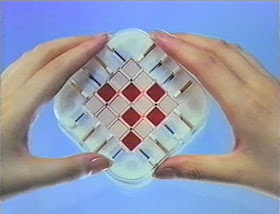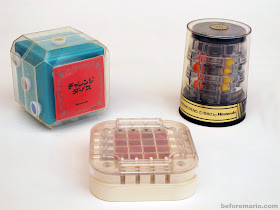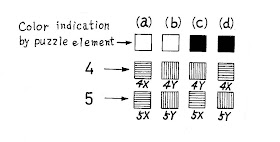Unlike the Ten Billion, which was sold in large numbers worldwide, only a small quantity of Crossover puzzles was produced, making it one of the more rare and sought-after Nintendo items from the toys and games era.
 |
| Nintendo Crossover (1981) |
The Crossover was advertised using the phrase「偏光スクリーン」, which means 'Polarized Light Screen'. The official English sub-title was 'Polarized Light Puzzle'. Why this is, we will get to in a minute.
Crossover was released in 1981, in three color variants: green, red or purple. It cost the same as the Ten Billion puzzle: ¥1,000.
 |
| Television commercial for the Nintendo Crossover |
The TV commercial for the Crossover shows the objective of this puzzle. With the sliders on the top, you move the tiles inside the crossover, which creates color patterns.
 |
| Move the tiles with the sliders, until they all have the same color |
Each tile can swap between two colors. For the red color variant of Crossover, the two colors are red and white. The green and purple variants use green and white and purple and white, respectively. Well, in reality the white is more like grey, actually.
 |
| The bottom row was moved and one tile changed color, the others did not |
As said, when the tiles move they can change color. At first glance, this seems to happen randomly: sometimes they change color, and sometimes they don't. It is quite puzzling and immediately intriguing.
 |
| Solved! |
The Crossover puzzle was an original invention, and Nintendo applied for a patent. This was granted in 1983 (US patent 4,402,510).
 |
| US Patent for the Crossover, simply titled "Puzzle Toy" |
The Crossover comes in a two-piece storage case.
 |
| Crossover with its storage case |
The puzzle consist of twenty-four square titles, arranged inside the puzzle housing in a grid of four rows and four columns. The tiles are visible through the transparent top. The aim of the puzzle is to correctly arrange the grid of four by four tiles in the middle, so they all show the same color (in this case, red or white).
 |
| The Crossover has four vertical and four horizontal sliders |
The two white sliders on the opposite ends of each row and column are attached to each others, so they move together. Using one of these sliders, you can move five tiles at the same time, in either a row or a column.
 |
| Bottom of the Crossover |
When we turn the Crossover over, we see the Nintendo copyright message.
Now, let's take closer look at these colors changing tiles.
 |
| Third column from the left is moved up, and tiles change color. |
In the starting position in the left image below, all tiles are colored red. In the middle image, we see how the entire second row changes to "white", when we move it to the left. Next, we move the second column up. As shown in the right image, the two bottom tiles change color, but the top two keep the same color.
 |
| Here is what happens when we move row #2 left and column #2 up |
So, how does this work? The images in the patent document come in handy to explain this.
 |
| Schematic taken from the Crossover US Patent |
The magic of the changing colors is all down to clever use of polarizing plastic sheets that filter out light waves in one direction: either vertically or horizontally.
On the inside of the transparent top of the puzzle (part 7a), small pieces of this polarizing plastic sheet are attached in a fixed position (parts 4), arranged in a pattern as shown below: alternating pieces that filter vertical or horizontally.
 |
| The inside of the Crossover top contains sixteen pieces of polarizing plastic sheet, eight vertically polarizing and eight horizontal |
Each of the twenty-four tiles in the puzzle (parts 1) also contains a piece of polarizing plastic (parts 5). These are also mixed, with eight filtering vertically and sixteen horizontally. As a result, when you look at the tiles, you are in effect looking through two layers of polarizing plastic sheet: one piece attached to the moving tiles, and one piece fixed at the top of the puzzle.
If the two layers are of the same polarizing type (either horizontal or vertical - 4x/5x and 4y/5y), light will shine through and you see the tile as white (greyish). If the two layers are of a different polarizing type (one of the vertical type and the other horizontal - 4y/5x and 4x/5y), the light is blocked, and you see the color (red, green or purple, depending on which variant of Crossover you have).
 |
| The polarizing pieces on the tiles (left) plus the fixed pieces on the puzzle top produce the effect shown on the right: if the two layers |
As an example, the particular arrangement of tiles with vertical and horizontal polarizing pieces as shown on the left-side of the diagram above produces the color effect as shown on the right. This is explained by the middle diagram. Here you see how the polarizing type of each of the tiles combines with the polarizing pieces fixed to the top of the puzzle. If they have the same polarization orientation (indicated by two bars that point in same direction) the tile will appear white. If they have a different polarization orientation (indicated by two bars that form a cross) the tile will appear colored.
Because of this mechanism, each tile can seemingly - as if by magic - either change or keep its color, when it is moved one position by sliding a row or column.
 |
| All three color variants of Crossover |
 |
| Three Nintendo puzzles: Challenge Dice, Crossover and Ten Billion |
If you are interested in the other Nintendo puzzles, check out the posts on Fifteengame, the Challenge Dice and the Ten Billion.



Hey I have one of these but I am a long way from Japan. Any idea when and where these were released worldwide?
ReplyDelete@anonymous: Very little is known about the distribution of this toy, although most have turned up outside of Japan in recent years (in UK and US).
ReplyDeleteWhere are you located, and how and when did you acquire this toy? Also, what color do you have? Hope you don't mind all the questions. Will add the info to the main post.
Also, if you are interested in selling it, please drop me an email (beforemario@gmail.com).
I am in Australia. I have had this for about 25 years. I always knew it was unique and special but until I read your site in the last couple of weeks I did not know what it was in had. It's the green one. I have never seen another in that time. It intrigues me as to how I got it. It was very random. How did it get to Oz in the 80's? Hence why I was asking about the distribution
DeleteI also have one in Australia, its the purple/white variant and i have the case, its in pretty good condition, just lost the instructions.
DeleteI have one. Not in the best condition, but nertherless I have one. It was brought off ebay. I asked the lady how she acquired it and she said her husband found it at a Carboot (flea market).
ReplyDeleteI have the barrel, but you missed the 4th puzzle nintendo manufactured: the Trillion puzzle
ReplyDeletehttp://www.jaapsch.net/puzzles/trillion.htm
Hi Anonymous.
ReplyDeleteThanks for the note, but according to my information the Trillion puzzle was not manufactured by Nintendo, nor invented by Gunpei Yokoi.
It has no link to Nintendo other than that it is inspired by the Billion puzzle. The link you sent does claim that it is an Yokoi invention, but I believe that to be incorrect.
I will post about this more extensively on this blog in the near future.
I have one of these too, with the red tiles, I got it off ebay a few years back but was just listed as Nintendo puzzle, it wasn't untill I got the History Of Nintendo Volume 1 that I knew its proper name and how rare it was.
ReplyDeleteHi Kevin. It seems quite some (of the limited number known) have made it to the UK. Is the one currently on eBay yours?
DeleteYes I put it on last night. I got mine over 5 years ago. I got it off ebay and the seller was in the USA.
DeleteI have one of these, i have the red one and have had this since i was a kid. It still works fine and is still in good condition. I still don't know how i obtained this in australia. From memory this was a gift as a child.
ReplyDeleteHi Eric,
ReplyDeleteI have recently rediscovered my crossover at my mother's house (UK) It is the green version and in excellent condition in it's original plastic container. I have no need of it now but would like it to go to a collector so I tnought I would contact you before listing it on ebay. Your blog is great and the only decent source of info on these items I could find.
Hi Baz. Please drop me an email so we can discuss this further. You can find the email address at the contact page of this blog.
Deleteso what are these actually worth i have the purple one according to write ups the rarest , last one i saw sold went for around $1200 american
Deletenot a purple one think it was a red
DeleteThis game reminds me of the later and non-Nintendo game called Lights Out.
ReplyDeleteI have the purple version of this game, been reading that it is quite rare, any idea on value?
ReplyDeleteLoza_ashby@hotmail.com
If it's in good condition and complete (with case and instructions) then crossovers tend to fetch between US$200 and US$500. Keep in mind that prices fluctuate quite a bit, as these do not come up for sale regularly, therefor the wide price range. Red and green ones appear more frequent, and will be on the lower end of the above price scale, although in the last five years I have seen more purple ones pop up as well. Maybe people have started looking harder in the back of their drawers?
DeleteHello,
ReplyDeleteFirst of all congratulations for your site. It is a very beautiful collection, richly illustrated and commented.
I'm looking for advertising you used some screenshots to illustrate your article.
Can you tell me if it is possible to view this commercial somewhere? on the Internet ?
Thank you again.
Hi! Good to hear you like the site. I am sorry, but that commercial is not out there to view, as far as I know.
DeleteI have a red one, with original instructions in great condition for sale. Replace the X in this email with T for my reply address ... XinbaXhcompo@hoXmail.com
ReplyDeleteNintendo Crossover 1981 TV Commercial now in YouTube https://youtu.be/JBLXO_gN0tY?t=344
ReplyDelete